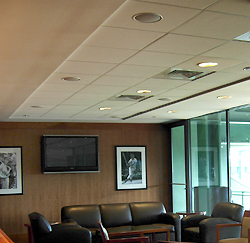
Finding the Ambient Sound Level. If the installation is in a location that is already in use, use an SPL meter set for slow response to measure the A-weighted ambient sound at the listener’s ear position.
Take measurements during the noisiest time and make sure the HVAC (air handling) system is operating during the test.
If the installation will be in a new facility, try measuring the ambient sound level in a similar type of venue.
Determining An Absolute Sound Level Goal. If the ambient sound level is low, then it’s possible that paging will still not be intelligible, so here are some guidelines.
For those not used to working with decibels, keep in mind that movie theaters are calibrated such that 85 dB is the level of the dialog when you’re sitting 2/3rd of the way back in the theater.
In the absence of background ambient sound, 85 dB is a good goal for excellent paging.
If people can understand dialog in a movie theater, they can understand a page at that level. 75 to 80 dB is often acceptable for paging. Below 75 dB and it starts getting difficult for some members of the population to hear or understand the page.
Choose the Appropriate Loudspeaker for Output Capability. Make sure the loudspeaker you choose has adequate power handling and sensitivity to produce the sound levels required. For good paging, the loudspeaker is typically required to sustain average speech levels that are at least 10 dB higher than the ambient noise level.
Cover Mid and High Frequencies. Choose a loudspeaker with the appropriate coverage pattern for your application. For intelligibility, select a loudspeaker that has especially even coverage in the 1 to 6 kHz range.
Power the Loudspeakers Adequately. Make sure the loudspeakers are driven with enough amplifier power to sustain the expected sound levels. It doesn’t help to have loudspeakers with enough output capability if you don’t provide enough amplifier power to drive them to that capability.
Clipping the power amplifier adds considerable distortion, degrades intelligibility, and results in unacceptable sound quality. Clipping is hard on the loudspeaker and can cause damage and failure.
